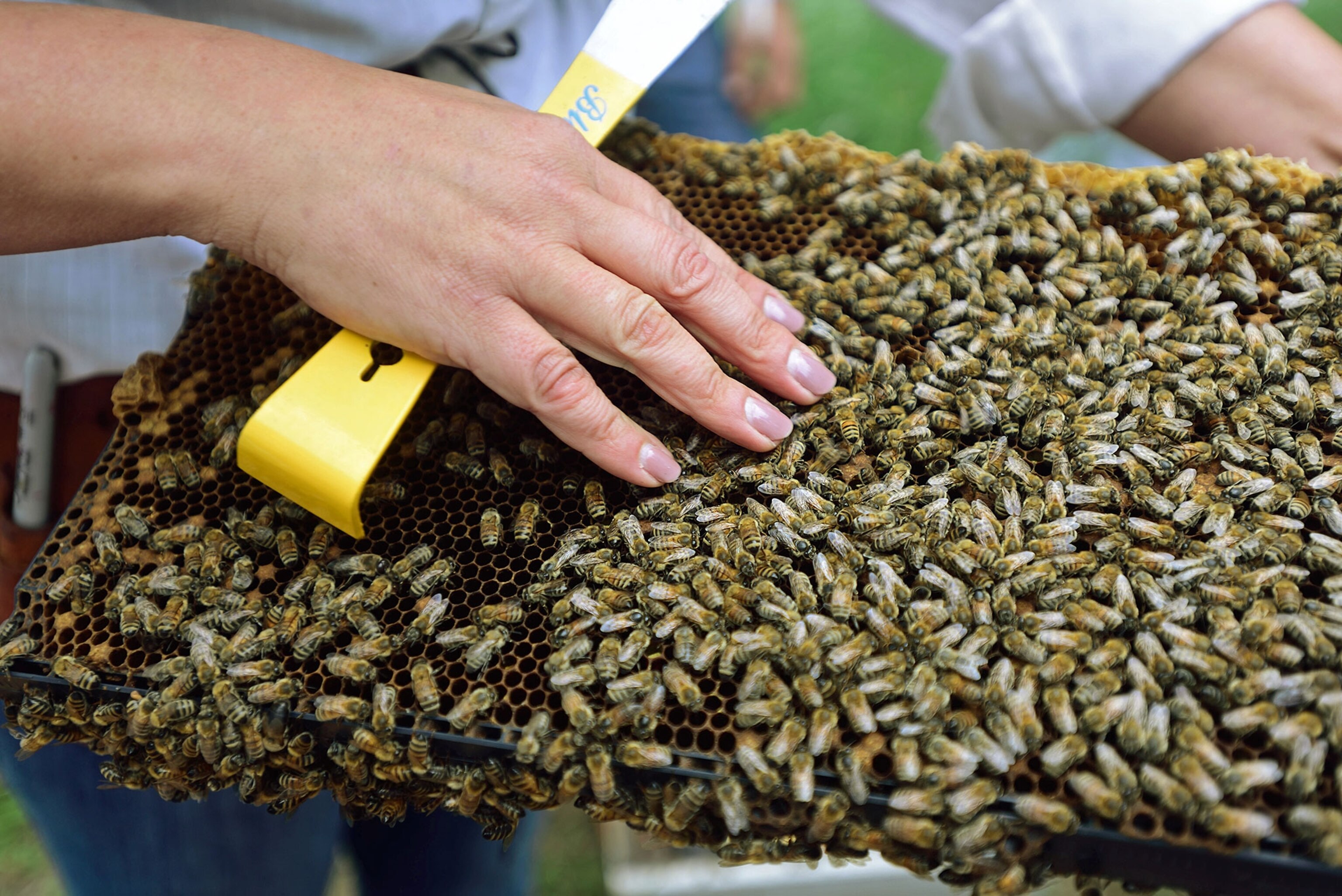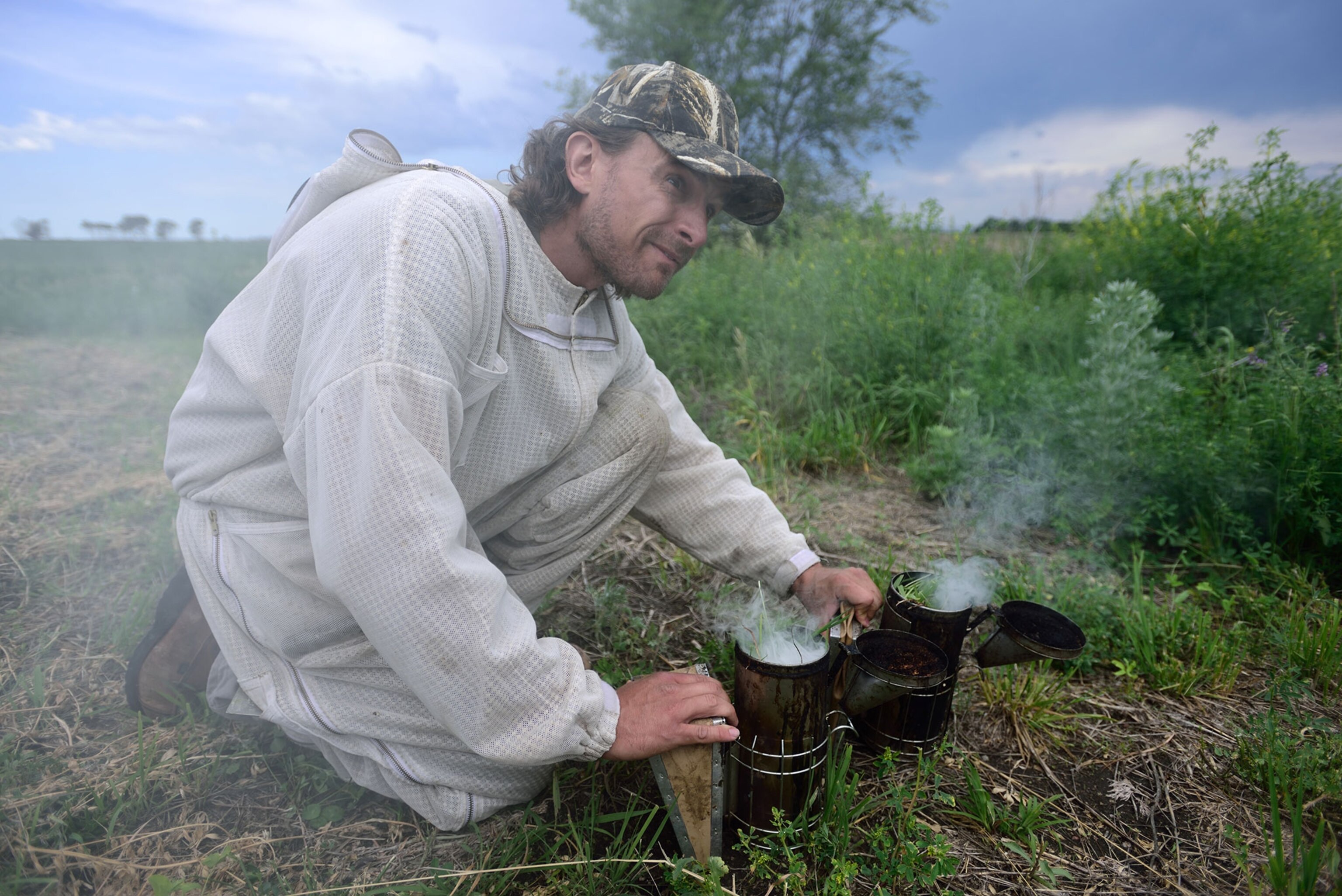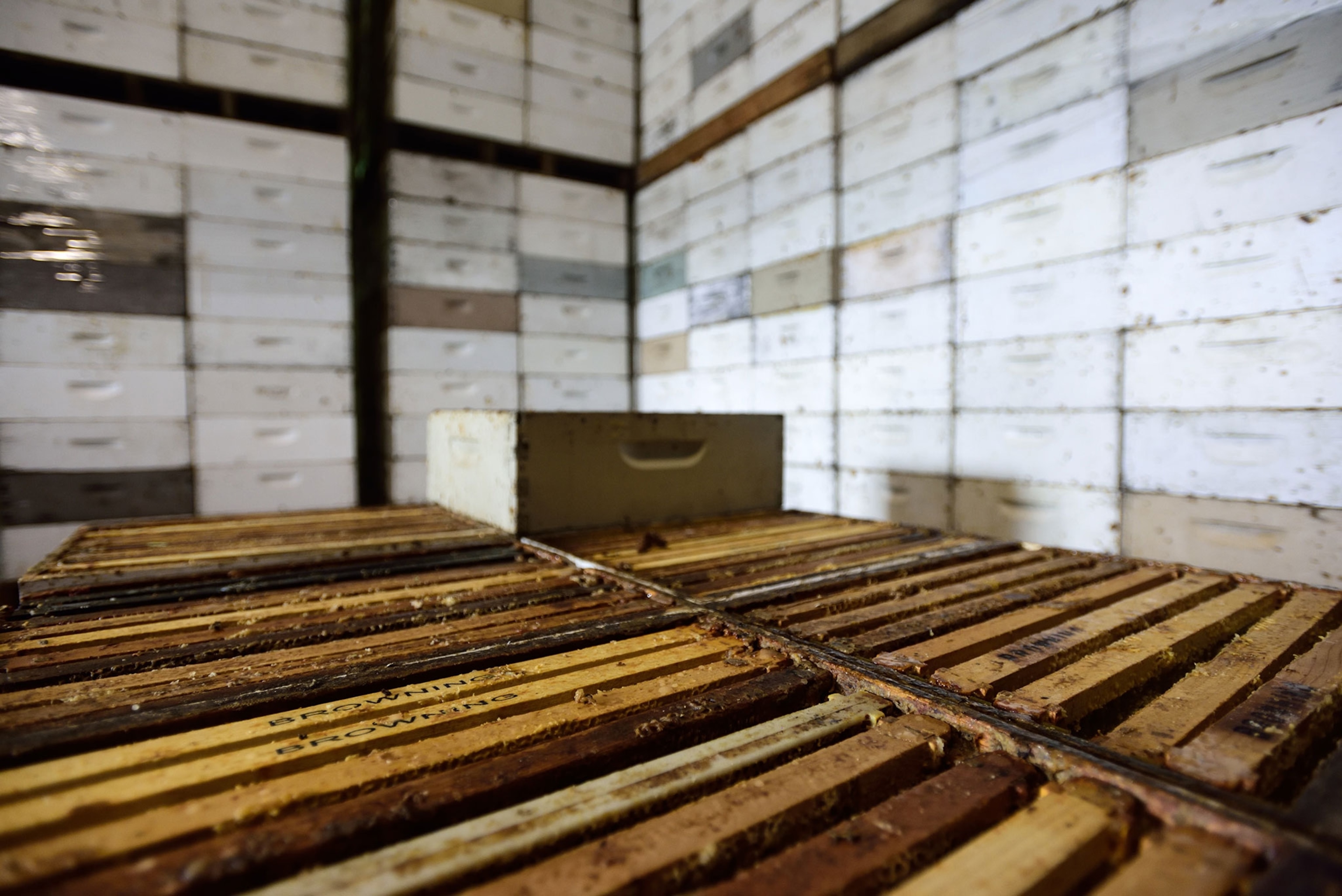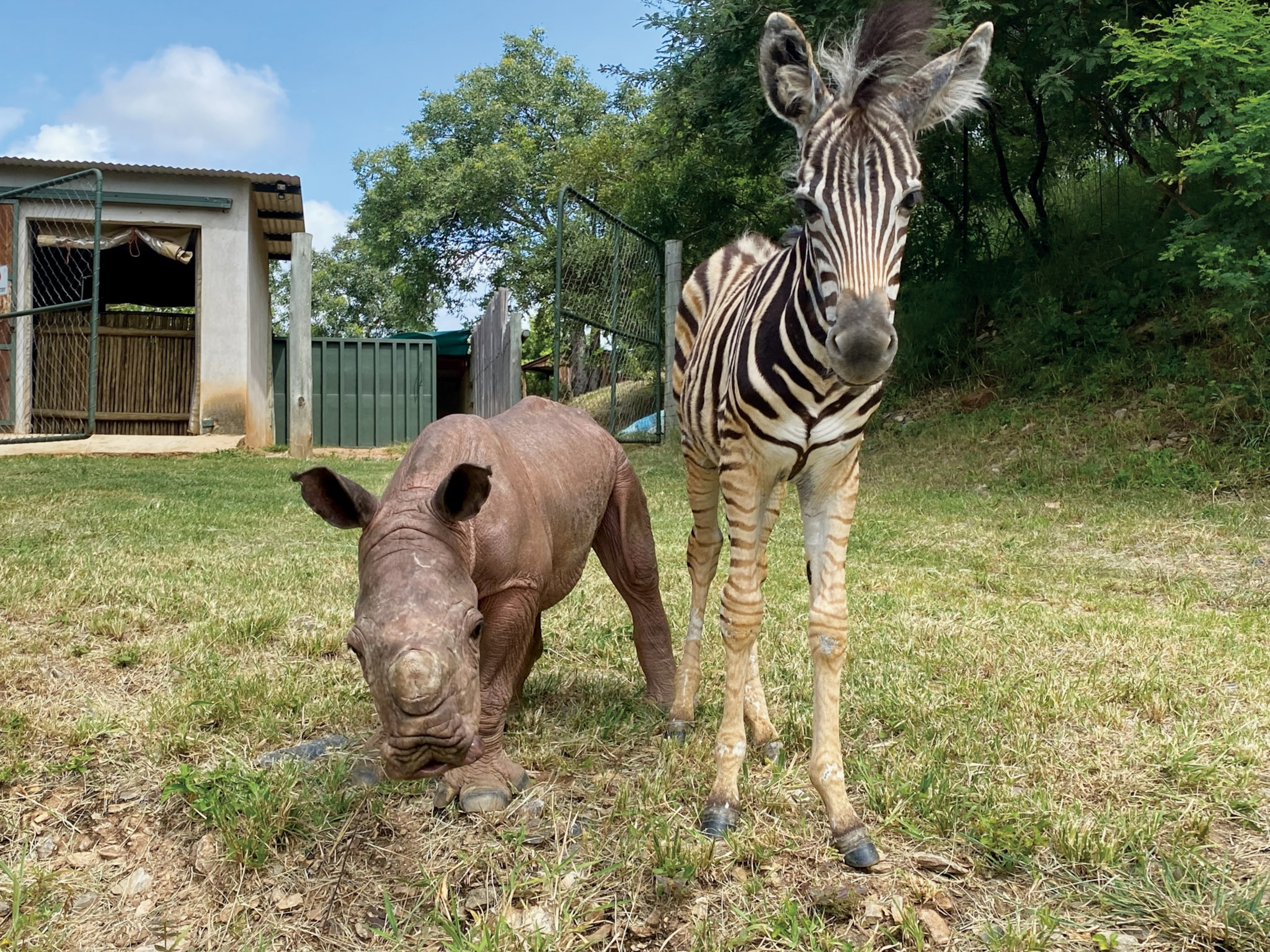
The Last, Best Refuge for North America's Bees
North Dakota, with its vast prairies, is perfect for raising honeybee colonies. But can its bees and their keepers, already facing so much stress, survive the widespread loss of grasslands?
Jamestown, North Dakota — Dressed in white and veiled in mesh, Zac Browning surveys his apiary, one of 500 beeyards he manages. Thousands of worker bees alight on stacks of wooden boxes, the tiny hair baskets on their hind legs heavy with pollen they collected from clovers, dandelions, and other wildflowers.
A fourth-generation beekeeper, Browning moved here from Idaho a decade ago in search of better habitat for his bees. He is one of hundreds of beekeepers who have flocked to North Dakota over the past several decades. About 250 billion bees—one in five colonies in the United States—spend the summer in the state, which produces about twice as much honey as any other in the country.
“North Dakota is the last, best place in North America to keep bees,” Browning says.
The state’s vast, open prairies with a sparse human population and scant agricultural development offer honeybees a safe haven. Buffered from farm pesticides, they can reap the nutritional benefits of pollen and nectar from a diverse array of flowering prairie plants.
But North Dakota is losing its prairie at an alarming rate.
For thousands of years, shallow wetlands—formed during the last Ice Age—have pocked this landscape, known as the Prairie Pothole Region. Originally stretching from Iowa north to Saskatchewan, it formed the largest grassland ecosystem on Earth. Today, a small fraction of this prairie remains, and what’s left has been splintered in the past decade.
Since 2006, North Dakota has lost more than half of the land that had been set aside for conservation in a federal program. Instead of leaving lands unplowed in exchange for payments, farmers increasingly are choosing to plant lucrative corn and soybean crops to meet the growing demand for biofuels.

These losses aren’t unique to North Dakota. More than 2,000 square miles of grassland—an area nearly the size of the state of Delaware—were converted to corn and soybean cropping across the northern Great Plains between 2006 and 2011.
The changes in land use have left beekeepers scrambling for scraps of disappearing habitat. Where Browning used to be able to house all of his hives within 70 miles of Jamestown, he's now stretched out over a 150-mile radius in his search for viable land.
"In the past seven years, we've lost 200 good beeyards," he says. "We're having to move our hives onto increasingly more marginal landscapes."
The Honeybee’s Plight
Honeybees are facing a suite of challenges. New parasites and diseases, growing pesticide use, changes in agricultural and beekeeping practices, and the loss of flowered landscapes have taken a toll on bee health. In 2006, beekeepers began reporting unprecedented die offs—adult honeybees were vanishing from their hives. Experts coined the term Colony Collapse Disorder and concluded that the phenomenon was likely due to a confluence of stressors.
While bees declined everywhere, U.S. beekeepers, who often maintain huge operations of more than 10,000 colonies, experienced the greatest losses.
“It’s gotten really hard to keep bees alive,” says beekeeper John Miller. Like Browning, Miller is a fourth-generation beekeeper who got his start in Idaho. He moved the family business to North Dakota in 1968, when grains and potatoes began to dominate the agricultural landscape in southeastern Idaho, leaving little room for the bees.
Miller, who keeps about 20,000 colonies, says he now factors in hive loss as an annual business expense. “On a bad year, we might lose up to 40 percent,” he says.

Miller and Browning say the problems started decades before Colony Collapse Disorder. When Browning’s grandfather and great-grandfather went into business in 1921, they could easily harvest a hundred pounds of honey per hive each year. The changes began after World War II. Commercial pesticides were introduced, farms got bigger and more mechanized. Larger farming equipment meant the fields could be leveled and drained more efficiently, with less left to fallow. Blooming crops such as alfalfa, which are a good food source for bees, were harvested and removed from the fields faster. By the late 1980s when Browning took over the family business, he struggled to pull in a 40-pound honey crop. He suspects the bees just couldn’t find enough nectar to make their honey.
Browning, like many commercial beekeepers, now makes a living on providing pollination services for almonds and other flowering crops. Each winter, 1.8 million honeybee hives are trucked from around the country to California’s almond orchards. The trip, however, takes a major toll on the hives: They are exposed to pesticides and disease.
“It’s the worst thing we do to our bees every year,” Browning says, “but it’s become an economic necessity.”

Bee Habitat and Health
Clint Otto removes a screen tray covered in tiny, mustard-colored pollen pellets from one of Browning’s honeybee boxes. The bees will spend the next several weeks at the North Dakota apiary, foraging and getting “fat and happy,” before moving later in the summer to pollinate canola blossoms in other parts of the state.
Otto, an ecologist at the United States Geological Survey’s Northern Prairie Wildlife Research Center in Bismarck, is leading a study across several states to better understand how land use and habitat influence honey production. He collects pollen from bees in a variety of habitats, and then tests the pollen for plant DNA to figure out which flowers the bees are visiting. So far, Otto’s detected genetic material from more than 260 different plant groups in pollen collected from North Dakota honeybees. Each type of flowering plant offers a slightly different set of nutrients. Bees, just like humans, need a variety of food choices for optimal health.
“Our provisional results highlight the importance of plant diversity for bee health and the need for maintaining landscapes with plants that flower at different times throughout the growing season,” Otto says.
Otto isn’t the first to investigate the link between land use and bee nutrition. A study published earlier this year found that North Dakota beehives surrounded by uncultivated land produced more honey than colonies in areas with intensive agriculture. Colonies with more access to pollen also had higher levels of proteins and fats in their blood, which are indicators of good nutrition, says senior study author Marla Spivak, a bee researcher at the University of Minnesota. Bees with better nutrition were more likely to survive through the winter almond pollination.
“We ask a lot of the bees. We need to find ways to be more gentle on them,” says Danielle Downey, director of operations for Project Apis m., a California-based nonprofit that researches and promotes honeybee health.
Preventing loss of prairie habitat won’t solve all of the honeybee’s problems, Downey says, but it can help mitigate losses now by providing them with sources of high-quality nutrition.

Also essential are building more sustainable agricultural systems that require fewer pesticide applications and devising practices to keep hives free of parasites and disease, she says.
Last year, Downey’s organization piloted a program with Browning’s Honey Company and the hunters’ group Pheasants Forever. In an effort to preserve and improve pollinator habitat, the group pays farmers to grow wildflowers on unproductive scraps of land and provides them with a special seed mix designed to attract bees and butterflies. The program so far has enrolled 124 landowners in North and South Dakota, with each contract averaging about 15 acres, says Pete Berthelsen, a biologist with Pheasants Forever and director of the partnership. Next year, they’ll extend the program to six states across the Upper Midwest.
Honeybees face extraordinary challenges, Berthelsen says. “There’s just one thing after another knocking them back. It’s like death by a thousand paper cuts,” he says.
Yet he remains optimistic that the new partnership can help to offset some of the losses while preserving key habitat for a variety of wildlife species.
“You see beekeepers, conservationists, hunters, landowners all working toward a common goal, and that’s very hopeful. The glass is half full.”
This report was supported by a fellowship from the Institute for Journalism and Natural Resources.








